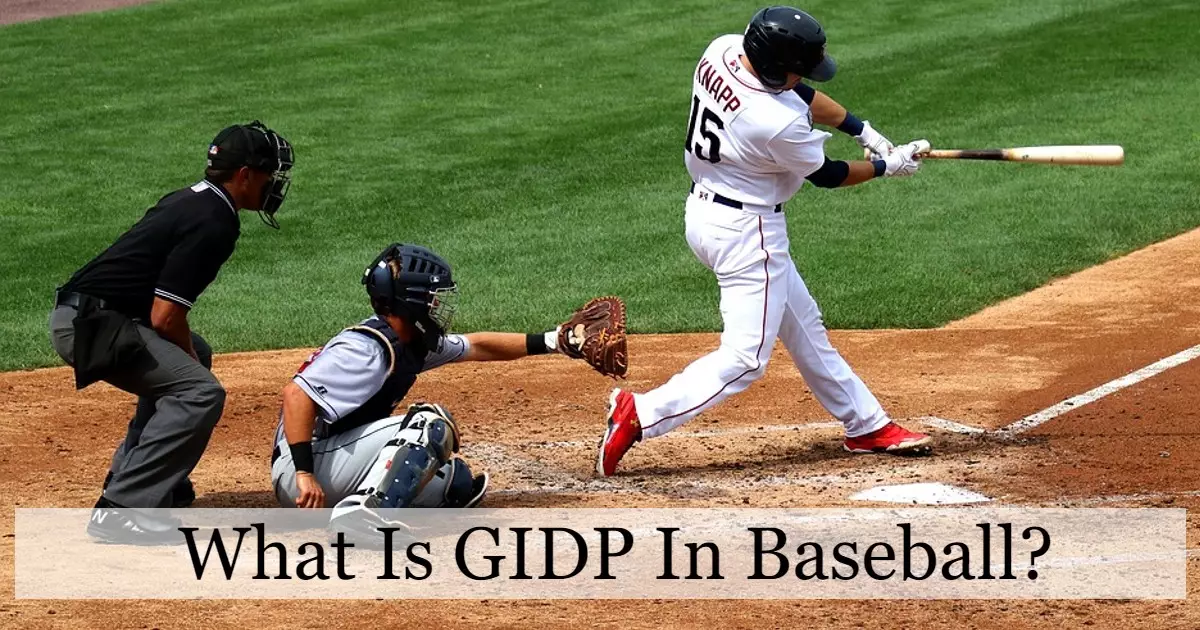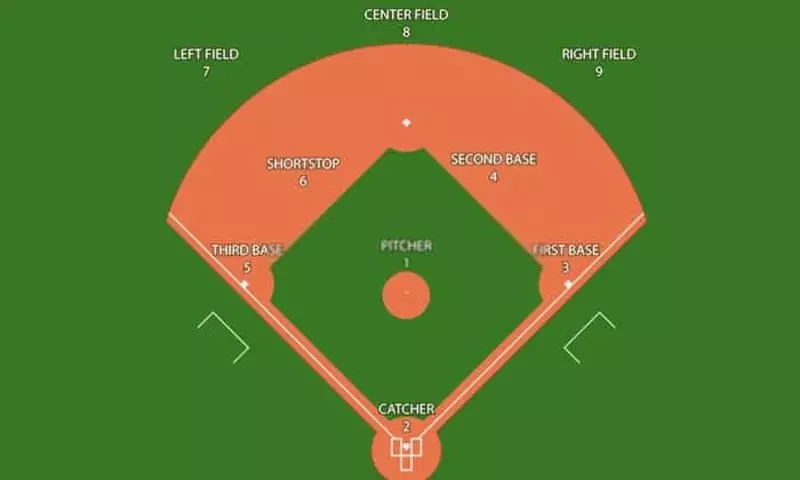Baseball, the national sport of Cuba, is an easy and fun game to play in warm weather. People all around the world enjoy playing this sport, both professional players and kids. You may be a big fan of this game, but do you know what GIDP in baseball actually is?
Playing baseball is very simple and exciting, although it is definitely among the most difficult sports. Notably, there are two teams, each of nine participants, who have to play defense and batting alternatingly after nine innings. The players of team batting can make hits by covering the distance to the three bases, and after completing the cycle, a home run is rewarded to the batter and his team, whereas team defense has to bowl to the team batting.
It is vital to note that the performance of players can be assessed by various statistical terms, which helps in grading them according to success. Some values are used to describe batting capabilities, like the batting average.
Likewise, another system to evaluate the performance of baseball players is Ground into Double Play, aka GIDP. Please note that it is not a statistical term, but an outcome of bowling is used to describe the bowlers’ performance. In this article, GIDP will be further described in detail as a reference to the bowling abilities of defensive team players. So, read on to learn everything about Ground into Double Play, GIDP.

What Does Gidp Stand For?
Content Summery
GIDP is a term used in baseball that stands for Ground into Double Play.
What Is Meant By Ground Into Double Play?
Ground into Double Play is an outcome term used in baseball to explain the action caused by hitting a ground ball with the batter.
Notably, GIDP occurs when a batter bats a ground ball, and the defensive team makes two outs while running the batters to the bases. What is essential for GIDP to occur is that the two outs have to result from a ground ball.
To get a better idea of GIDP, the knowledge of ground ball and double play is necessary. So, Let’s quickly delve into these two important terminologies of baseball.
What Is A Ground Ball In Baseball?
A ground ball is a bowling pattern by the bowler, which results in such an act of batting that causes the ball to bounce into the field under the protection of the opposing team’s fielders. So instead of referring to the bowler, the ground ball refers to the batter who hits the ball into the field.
Furthermore, the ground ball has a low trajectory and travels by bouncing rather than a high fly, which makes it easy to be caught by the fielders. Therefore, a ground ball is considered a good outcome for the bowlers and a poor act for the batters as the batter faces a danger of getting out.
Also, it is noteworthy that bowlers who often bowl ground balls are praised more and considered good. The significance of ground ball is that it can lead to Ground into Double Play, resulting in outs of two batters from the opposing team.
What Are A Play And A Double Play In Baseball?
In baseball terms, play means the effort carried out by a bowler during his inning of bowling to catch the batter while he is running to the base and retire him. When the bowler succeeds in getting the runner out, he has achieved a play.
Similarly, if a bowler retires two runners in a single inning, he has performed a double play. A ground ball does not always cause a double play; hence all double plays are not known as GIDP, but when a ground ball becomes the sole reason for the double play, the outcome is known as Ground into Double Play, aka GIDP.
How Does Ground Into Double Play Occur?
Now that the literal meaning of GIDP is known, it can easily be understood how it occurs. In baseball, there is a rule that as soon as the batter strikes the ball, he has to run to the first base and the player already at the first base has to run to the second base during this period.
When a bowler bowls to the batter in such a way that the batter is forced to hit a ground ball, the ball makes its way into the field at a slow pace and is readily available for the fielders to get hold of.
Also, once a fielder catches the ball, he throws it towards the first base quickly before the batter can reach the base and is on his journey towards it, resulting in the out of the batter.
The fielder at the first base then throws the ball at the second base, which is yet not occupied by the runner running towards it, resulting in an out of the second runner from the same team.
Moreover, when two batters of a team get out simultaneously in the same inning due to a ground ball, it is known as Ground into Double Play and is attributed to the excellent performance of the bowler.
When Is Double Play Attributed To GIDP?
Double play refers to two retirements or outs in a single inning, be it caused by a ground play or any other reason, whereas GIDP refers to the double play caused solely by the ground ball. Subsequently, there is a situation when the batter who hit the ground ball is not out, but there is still a GIDP.
Please note that it occurs when the batter at the home base successfully reaches the first base without getting caught, but the runners previously were at the first and second base.
Also, the runner has to make it to the next bases and get caught during their run. In this type of situation, the double play is referred to as a GIDP and is attributed to the batter at the home base, even though he did not get caught.
Types Of Ground Into Double Play / GIDP
There is no strict categorization of GIDP; in fact, there is a long list of its types depending upon the order of fielders who field the ball. Precisely speaking, nine fielders in the defending team have designated positions, and each position is allocated a number from 1 to 9.
The types of GIDP are categorized according to the number of the fielder who fields the ball first and transfers it to the fielder of another number. The positions on each number are defined as follows,
- Pitcher
- Catcher
- First Base
- Second Base
- Third Base
- Short Stop
- Left Field
- Center Field
- Right Field
These numbers and their positions are used to name the types of GIDP, for example:
4-6-3: In this type, the fielder at position 4 got hold of the ball first and passed it to the fielder at position 6, who transferred it to the person in position 3.
5-4-3: In this type of GIDP, the ball is first caught by the 5th position, passed to the 4th position, and further transferred to the 3rd position in order to get a double play.
Misleading Concerns Of GIDP
GIDP is misleading in some cases; for example, when the batter is not out during the double play and instead the runners already in the field at first and second bases are out, the GIDP is still attributed to the batter at the home base.
Moreover, it is noteworthy that the total GIDPs of the batter do not indicate whether the batter himself got out in the double play or the other two runners got out.

Records Of Highest GIDP Of A Bowler/Pitcher
In the history of baseball, no bowler has ever achieved more than 500 GIDPs except for one, Tommy John, who has succeeded in achieving more than 600 GIDPs. Notably, Tommy John was an American baseball player who earned high-performance records during his career from 1963 to 1989.
Final Words
To conclude, baseball is played in three major roles; batting, bowling, and defending (fielders). Each position has its own performance grading, and there are many systemic values and terms to describe the performance.
Subsequently, Ground into Double Play is a term describing a good bowling capability, and it refers to a double play due to a ground ball hit by the batter.
Ground ball makes it easy for the fielders to catch the ball and pass it on to more than one base station orderly to retire two batters at once, may it be the batter at the home base and the runner at first base, or the runners at first and second bases sparing the batter at home base.
Whether the batter at home base is out or not, the GIDP is attributed to him.
FAQs
Q. What is meant by GIDP, and what does it stand for?
GIDP stands for Ground into Double Play, meaning that the batter hits a ground ball, and the fielders retire two runners in the field during the same inning.
Q. In what situation is there a double play but not a GIDP?
In cases when there is a double play in an inning but for some other reason, instead of a ground ball, there is no GIDP.
Q. Is GIDP a determinant of the success of a bowler or the batter?
GIDP is used to assess the performance of bowlers; the bowlers who have more GIDP scores are graded in the upper levels of performance and reflect a successful career, whereas the batters with a higher GIDP score are graded lower in the performance scores.
